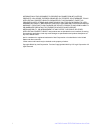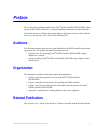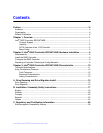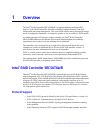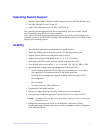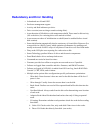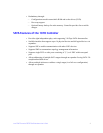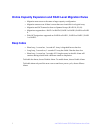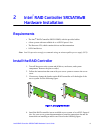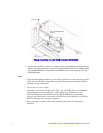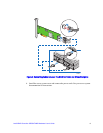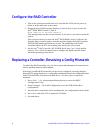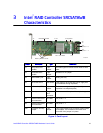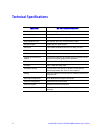3 Intel® RAID Controller SRCSATAWB Hardware User’s Guide
Redundancy and Error Handling
• In-band and out-of-band SES2.
• Enclosure management support.
• Activity and fault indicators per drive.
• Drive coercion (auto-resizing to match existing disks).
• Auto-detection of failed drives with transparent rebuild. There must be disk activity
(I/O to the drive) for a missing drive to be marked as failed.
• Auto-resume on reboot of initialization or rebuild (must be enabled before virtual
disk creation).
• Smart initialization automatically checks consistency of virtual disks if there are five
or more disks in a RAID 5 array, which optimizes performance by enabling read-
modify-write mode. RAID 5 arrays of only three or four drives use Peer Read mode.
• Dirty cache LED plus error reporting for cache write to disk.
• Smart Technology predicts failures of drives and electronic components.
• Patrol Read checks drives and maps bad sectors.
• Commands are retried at least four times.
• Firmware provides best effort to recognize an error and recover if possible.
• Failures are logged from controller and drive firmware, and SMART monitor.
• Failures are logged in NVRAM, viewable from OS Event Log, Intel
®
RAID Web
Console 2; CIM, LEDs, and via alarm.
• Multiple cache options allow configuration-specific performance optimization:
— Write-back. Faster because it does not wait for the disk but data will be lost if
power is lost.
— Write-through. Usually slower but ensures data is on the disk.
— Read Ahead. Predicts next read will be sequential and buffers this data into the
cache.
— Non Read Ahead. Always reads from the drive after determining exact location
of each read.
— Adaptive Read Ahead. Reads ahead and caches data only if doing sequential
reads.
— I/O setting. Determines whether read operations check the cache before reading
from disks.
✧ Cache I/O: Checks cache first, only reads disk if data is not in the cache.
✧ Direct I/O: Reads data directly from disk. (not cache)




